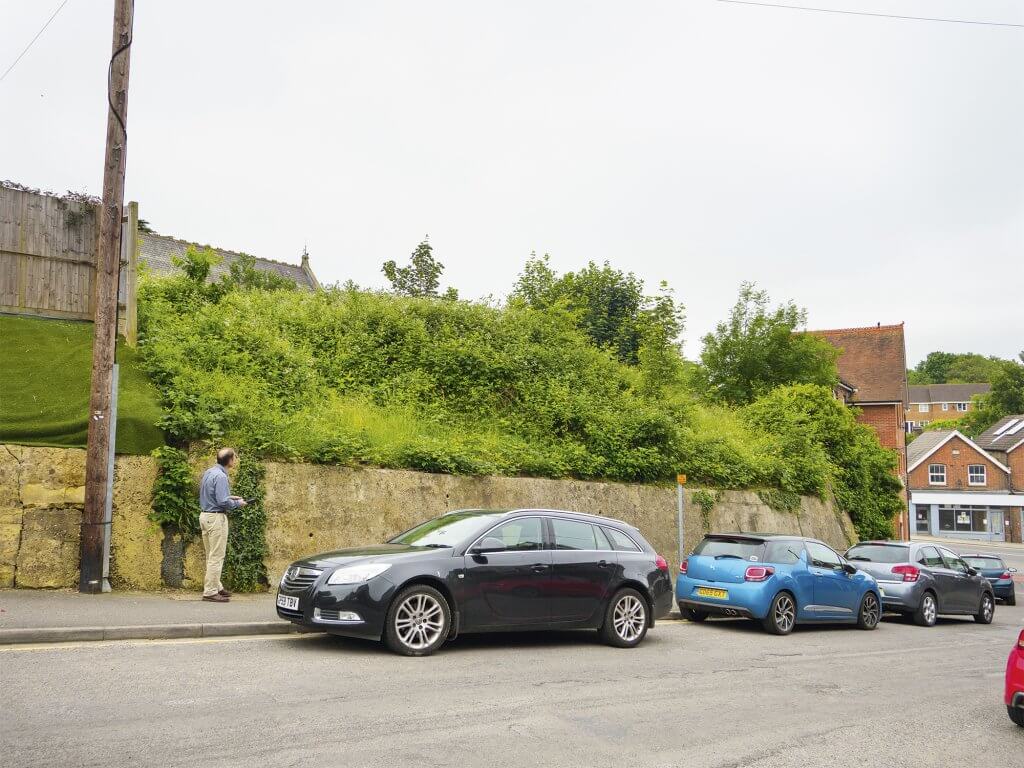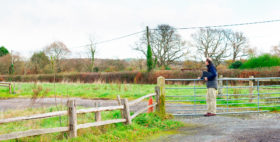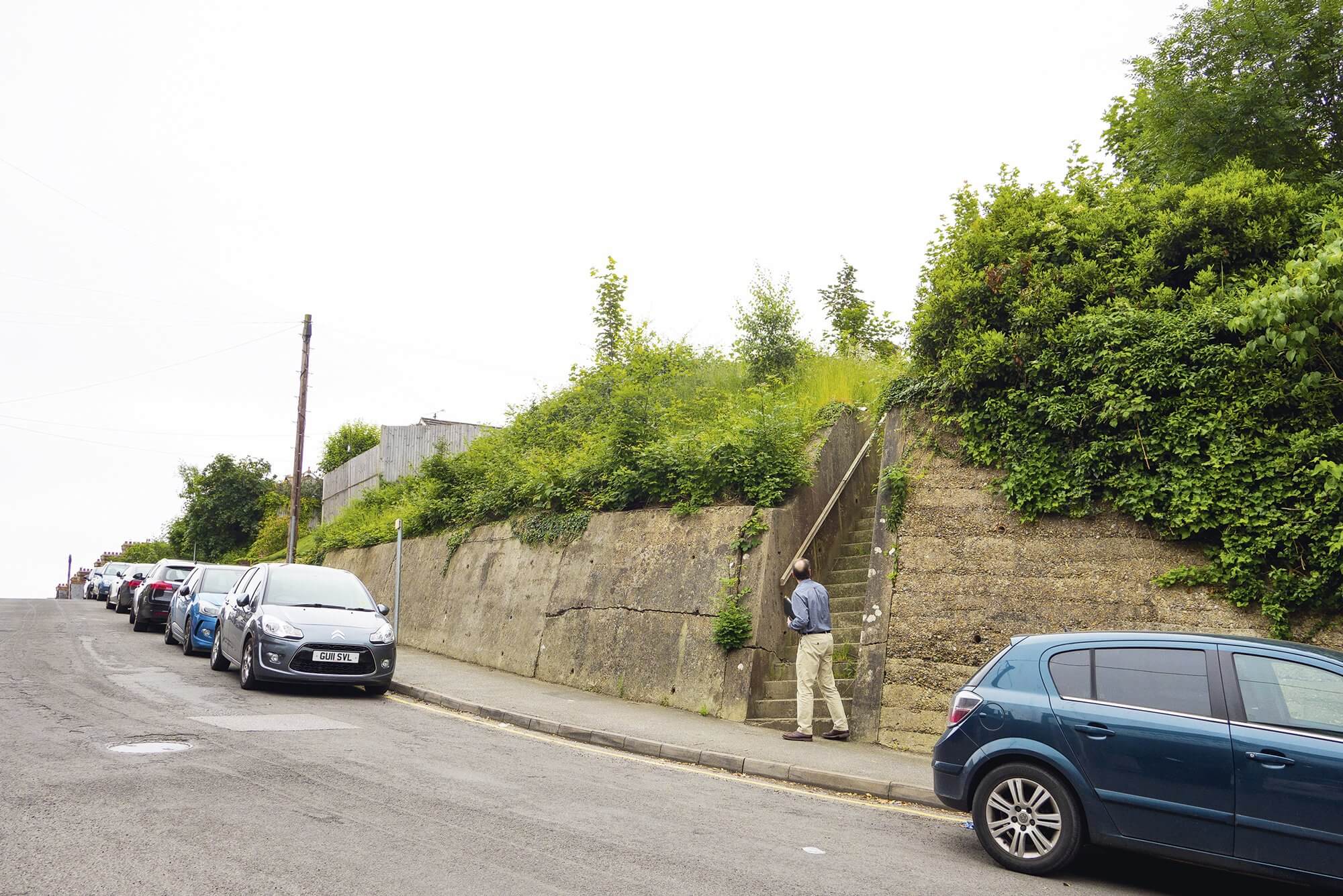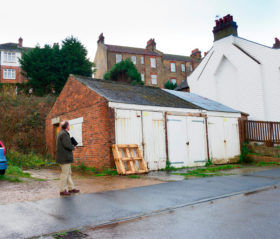Ray and Maya Kerr are keen to build their own home and have spent a good deal of time poring over magazines, attending self build shows and looking at catalogues. They love the idea of designing an energy-efficient house that suits their lifestyle and tastes.
The couple wants to live in their hometown to be close to friends and family, but in the last twelve months not a single building plot has come onto the market. They’re now searching for suitable looking bits of land to see whether an owner would be willing to sell.
| Who | Ray & Maya Kerr |
| What | A patch of overgrown land high up from the adjacent road on a retaining wall |
| Where | East Sussex |
They have found a conveniently central overgrown site that doesn’t seem to serve any particular purpose. Could this become a viable building plot? How can they find out and go about trying to buy it?
How did they find the plot?
Ray and Maya found this patch by looking for empty spaces on Google maps. While searching, they quickly discovered that many promising-looking sites – particularly on housing estates – actually serve some amenity purpose. This means they were probably designed as part of a landscaping scheme when the estate was laid out.
But this plot is different; it’s tucked behind high street shops, with a frontage to a side road.
The plot measures about 20m wide and 25m deep, it appears to be just overgrown grass, scrub and brambles. Ray and Maya have discovered it’s been in much the same state for the last 20 years.
The obvious challenges are its elevated position next to the adjoining street and large concrete retaining wall, which is around 1.5m-3m tall. There are no windows overlooking the plot on the neighbouring properties, so a new house shouldn’t cause amenity issues.
Finding out who owns the land
With a site like this, it’s important for the Kerrs to quickly find out who owns it and whether they’d contemplate selling the land.
Equally, that exercise is pointless if there’s little prospect of gaining planning permission. Luckily, the initial steps in investigating both questions can be done with minimal commitment of time or money.

The site is elevated next to the adjoining street and has a large concrete retaining wall
The district council’s website is a good place to start on the quest to working out who the landowners are. Here it should be possible to research whether any planning applications have been made on it and, if so, who by.
Many authorities’ websites have a map search resource which would be handy here in the absence of any obvious address. If this isn’t available, it might be necessary to look at all applications in the road and trawl through to see if the site comes up.
If there has been an application on this site, the owners’ names will be on the forms. If there’s no planning history, Ray and Maya can try the Land Registry online search facility, although property that hasn’t changed hands for many years isn’t always registered.
If that doesn’t yield anything it will be down to good old-fashioned detective work, asking around to neighbours and local shops.
Pre-application advice
As the land is within a town, infilling and small-scale housing is likely to be acceptable in principle. The couple could put some sketches together and seek pre-application advice from the council to confirm this – they don’t need to own the land, or have the owners’ permission to do so.
However, with a site like this there are some issues to address around the retaining wall and how access could be gained, which they need to look into before they contact the council.
Another planning concern that will need investigation is the question of whether the site might harbour any protected species. Even in a town, overgrown land like this can be home to badgers or reptiles and because it’s so overgrown it’s difficult to tell what’s there.
The presence of protected species is rarely fatal to the prospects of developing a plot, but Ray and Maya will need to factor the cost of an ecological survey into their budget.
The big retaining wall at the front of this site raises a number of key questions. Is it stable and will it need repair or replacement? How could you get access into the plot? Are the ground conditions on the land itself stable?
Any or all of these points could have significant implications for the cost of developing the land, which could be the reason the site hasn’t been built on thus far. An initial chat with a surveyor or the council’s building control department should give the couple an idea of what they might be up against.
Another thing to consider is whether they would actually need on-site parking. The location is a short walk from the town centre, with a station and bus service nearby, so they would only have a limited need for a car.
There’s on-street parking, although inevitably in such a central location, this gets pretty full up. A scan through town centre planning applications might give some clues as to the local authority’s attitude towards the need for on-site parking in this area.
Cost of surveys before buying the plot
If Ray and Maya can establish who owns the site and whether the owners would consider selling, the practical points about the retaining wall and ground conditions will need investigation before they can make an offer.
This means spending money on a structural survey and getting an idea of build costs, before finding out whether any offer they make might be accepted by the owners.
To minimise their risk of futile expenditure, an ideal way forward for them would be to agree an option to buy. This would give them the exclusive right to purchase and the time to sort out costings and planning.

If they could agree, within the option contract, to pay a percentage of the open market value – say, 80%-85%, then this would protect them if they uncover exceptionally high build costs that depress the market value.
The benefit of this arrangement for the seller is that they effectively avoid all the up-front fees of getting planning consent but are assured of being paid a fair market price.
Should the couple pursue this plot?
Ray and Maya have done well to spot a potential plot, but this one could come with challenges. The big retaining wall might mean substantial additional costs and the essential thing is that Ray and Maya fully reflect this in their budget and any offer they make.
There are also uncertainties over planning and, fundamentally, whether the owners of the land would be willing to sell. With limited opportunities in the town, Ray and Maya could start with some initial investigations on both the ownership and planning without significant fees.
If the site still appears a possibility after those initial stages, they’d need to secure an agreement to buy that enabled them to progress the more detailed and costly investigations without fear of being gazumped. It’s not a straightforward proposition, but it is one that might just bear fruit given a careful approach and a little luck.
Would you like Mike Dade to cast his expert eye over a plot or project you’re considering?
Email us on [email protected]
Mike can also be contacted through his consultancy at www.speerdade.co.uk































































































 Login/register to save Article for later
Login/register to save Article for later












